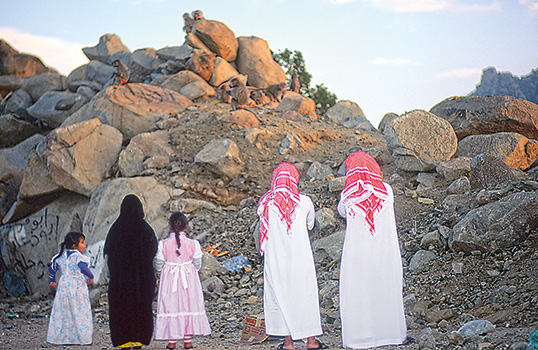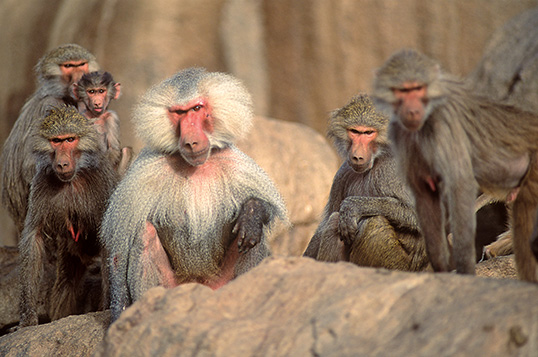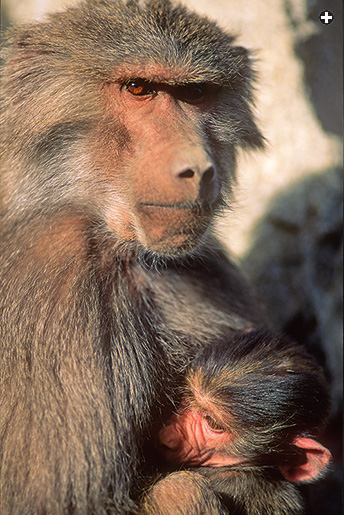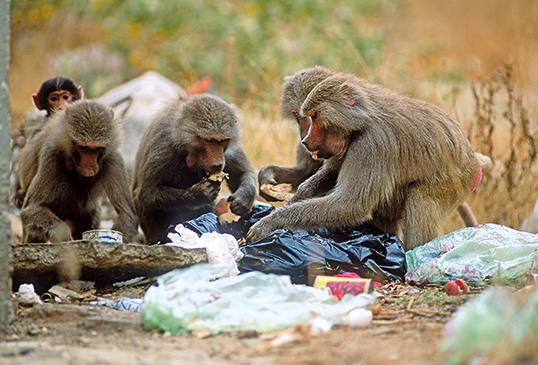
“I was ten years old—I’ll never forget it.” Ahmed Boug gazes across a hazy desert view from the highlands above Taif, in western Saudi Arabia. “We’d set off for a camping vacation in Abha, up in the mountains. This was before there was even an asphalt road there. It was wilderness, high above the town. At dawn my father woke us all in a panic. ‘Monkeys!’ he was shouting. ‘Quick, get everything!’ We grabbed what we could. There were about a hundred of them coming through. They stole fruit, food, anything. Later, we went down into the valley to retrieve our stuff—shoes and toys. It was all such a shock for me! That was what sparked my interest in these animals.” A child’s interest became a professional’s preoccupation.
Today, as director of Saudi Arabia’s National Wildlife Research Center (nwrc), Ahmed Boug is a world authority on the backcountry raiders who so shocked him as a boy—hamadryas baboons.
 |
| The rugged Sarawat Mountains offer ideal habitat to hamadryas baboons. Although some 65 percent remain wild, 35 percent live— and feed—near towns and cities, including roadsides such as those along Highway 15 west of Taif. |
Unlike olive, yellow, chacma and Guinea baboons, all of which are found only in Africa, Papio hamadryas live on both shores of the Red Sea, ranging from Ethiopia, Eritrea and Somalia across the water to the semi-arid mountains of Yemen and Saudi Arabia. Homo sapiens aside, they are the Arabian Peninsula’s only endemic primate.
Hamadryas need surface water for drinking and rocky slopes, even cliffs, for sleeping. In Saudi Arabia, where they number perhaps 350,000, these conditions prevail in the Sarawat Mountains, north from the border with Yemen for roughly 800 kilometers (500 mi), parallel to the Red Sea coast. It is a narrow corridor: In the deserts east of the Sarawat there are cliffs but no water, and on the coastal plain west of the Sarawat there is water but no cliffs.
Boug’s home city, Taif, perches at nearly 1900 meters’ altitude (6200') in the Sarawat. It is so suitable for hamadryas that it has become famous for them. Especially around its western outskirts, they cavort by the hundreds across rocky slopes, loiter near parks and cajole leftovers from amused Homo sapiens.
Boug drove me out a few kilometers northwest to Al Hada, where Makkah-bound Highway 15 begins its descent off the escarpment in a series of precisely engineered hairpin turns. In a pullout before an epic desert vista, we watched as hamadryas males and females, adults and infants, all bounded over the rocks lining the shoulder and over the four-lane highway, at times appearing to literally dance in the road. Directly beneath a large sign reading Mamnooa rami al-akl lil-haywanat (“Do not throw food to the animals”), drivers were nonetheless stopping to toss fruit, bread and leftovers out of car windows, drawing clusters of screeching, somersaulting baboons onto car hoods and roofs.
 |
| Above: A family watches cavorting baboons along the roadside. Below: Socially, Hamadryas baboons organize into omus (“one-male-units”) such as this male flanked by four females. |
 |
 |
| Crossing the red sea |
How did African baboons end up in the Arabian Peninsula? Or was it the other way around? It’s a question that has taxed primatologists for decades. As Hans Kummer wrote in his 1995 landmark book In Quest of the Sacred Baboon, “It is a puzzling situation. The hamadryas must have originated on one side or the other [of the Red Sea]. As yet, we do not know which.”
Other mammals present on both shores of the Red Sea differ substantially from one another: Oryx and leopards, for instance, both show marked physiological and behavioral variation between African and Arabian populations. Papio hamadryas, though, is essentially the same. This implies a long period of isolation, in which the species evolved to its present form, followed by a relatively recent spread of population to fill the current range.
Kummer favored an African origin, putting forward the intriguing idea that the baboons were transported across the sea by the ancient Egyptians, who are known to have worshiped the animals. (Around 1500 bce, Queen Hatshepsut is recorded as having sent out an expedition to the “Land of Punt,” presumably in the Horn of Africa, which brought back live hamadryas baboons.) Kummer suggested that at some point during the rise of maritime commerce on the Red Sea, baboons simply jumped ship and established pioneer colonies in the mountains above Arabian Red Sea ports.
If he is right, the African and Arabian populations of hamadryas would be genetically identical. But he was working from observation, before DNA testing was widely available.
In the laboratories of the King Khalid Wildlife Research Center outside Riyadh, a team working under British geneticist Bruce Winney announced in 2004 that diversity in the mitochondrial DNA (mtDNA) of Arabian baboons indicates that colonization of Arabia must have taken place earlier than 20,000 years ago—long before the emergence of human civilizations.
The baboons, therefore, made the journey themselves.
But how? Did they migrate slowly northward from Ethiopia into Egypt, traversing the Sinai Desert to enter Arabia from the north? If so, populations at the northern edge of the hamadryas’ current range would be genetically closer to African populations than those to the south. But Winney’s analysis showed marked genetic diversity between samples taken in both Eritrea and Taif, at the northern limit of distribution on both shores.
So scientists looked south. The Bab Al-Mandab strait, which separates Djibouti from Yemen at the mouth of the Red Sea, is only 30 kilometers (18 mi) wide. During periods of glaciation, global sea levels were much lower, and the strait would have formed a land bridge at several times over the last half-million years, leading Winney and his team to conclude that baboons likely crossed from Africa to Arabia between 130,000 and 440,000 years ago.
Then primatologist Takayoshi Shotake of Kyoto University, working closely with Ahmed Boug in Taif, suggested that, at some point in the distant evolutionary past, an ancestor of the baboon crossed the Bab Al-Mandab strait into Arabia. The hamadryas then evolved its distinctive characteristics in Arabian isolation over hundreds of thousands of years, before crossing back into the East African mountains. A genetic difference between African and Arabian hamadryas detected in recent analysis appears to bear this idea out. Shotake’s research is still in preparation, and so his hypothesis remains untested, but it offers a tantalizing, intriguing possibility. Far from being a marooned African animal, hamadryas might be Arabian. |
Hamadryas are not lithe, slender tree-dwellers: They are short, stocky and powerful. A full-grown male can weigh in at 30 kilograms (66 lb), and his long, squared-off muzzle opens to bare five-centimeter (1½") canines. With a silver mane that fluffs to form a broad cape across his cheeks, shoulders and upper body, and narrow eyes that dart intently beneath prominent brow-ridges, everything about his appearance signals size and strength.
Females are only about half as large, and their short, brown hair lacks the male’s impressive mantle. Socially, the males call the shots, corralling females around themselves in the polygynous building-block of baboon society, the “one-male unit” or omu, as Boug explains. As we watched the fluster of baboons on the highway shoulder,
Boug pointed out several omus: In each one, a male controlled two to eight females, plus their infants. There are larger divisions, too, he explained: Two or three omus live and feed to; gether as a clan; two or three clans maintain close contact as a band and several bands form a troop that may be composed of a hundred or more individuals who travel en masse from sleeping sites to feeding sites to resting sites and back each day.
Within each group, social order is a mixture of consent and coercion: It’s not uncommon to see a male attempt to prevent a female from straying by hauling her around by the tail. This behavior, Boug adds, is different from that of African male baboons, which fight each other for females. “It’s an adaptation to the more arid environment here. Herding your females takes less energy than fighting another male to win them back. Conservation of energy is a key priority.”
Despite his expertise, Boug has been working alone for much of the last three decades. Only a handful of scholarly papers have been published on the hamadryas populations in
 |
| Matthew Teller |
| ”We have to stop people feeding baboons,” says Ahmed Boug, above. Commensalism—baboons subsisting partly or entirely on human food—is causing social stress. For females, below, commensal overeating reduces birth intervals, contributing to overpopulation. |
 |
Arabia as compared with African species. It’s as if hamadryas baboons got left behind while human understanding of other parts of the natural world has grown over the last century. Swiss primatologist Hans Kummer has offered a hypothesis about this. A pioneer of hamadryas research, he first worked on Ethiopian hamadryas in the 1960’s. Whereas most mammals entice each other to mate using scents imperceptible to humans, or sounds we do not perceive as sexual, he wrote, baboons are visual animals, and their physical displays and sexual exuberance are understandable to humans as such. What’s worse, he added, is that they appear to be half-dressed: the male’s mantle covers his shoulders, but—like the female—he is naked from the waist down. Baboons, to some, are simply embarrassing.
In Arab culture, although baboons are mentioned in the hadith, or sayings of the Prophet Muhammad, they are significantly absent from a rich poetic tradition that otherwise names every kind of wild animal, from oryx and gazelles to wolves and even the universally unpopular hyena. Ahmed Boug—himself a literary scholar and published poet—laughs as he delivers an explanation tantalizingly close to Kummer’s. “Baboons are neither beautiful to describe, nor good to eat,” he told me. “So the poets ignored them.”
That uneasy relationship persists. Only around 65 percent of Saudi Arabia’s baboon population is wild; the rest live in and around towns and cities, particularly Taif, which happens also to be the kingdom’s top leisure-tourism destination. These baboons are classified as commensal—meaning they “share our table”—which means that, to varying degrees, they rely on human food.
Boug took me to the south side of Taif, to Wadi Liya, where all the elements of a baboon habitat unite. The valley is steep-sided, with rocky cliffs, smaller wadis and springs nearby that channel water to where a dam has created a lake. As well as eating wild acacia fruit and the succulent roots of the prickly poppy (Argemone mexicana), the baboons make the short walk every morning to Ruddaf Park, a local picnic area, where they raid the dumpsters and trash bins for human leftovers, gathering as much as possible before the park rangers arrive for work and chase them off.
 |
| With food too easily available, baboons’ roaming territory contracts and, like humans, under-exercised baboons develop physical health problems. |
“Commensalism has been a problem here for a long time,” Boug tells me. “But it’s grown worse in the last 30 years, as rapid development has overtaken environmental issues.” Four percent of the baboon population—that is, several thousand individuals—are now completely reliant on human food sources.
But, as the drivers at Al Hada demonstrate, it’s not just about raiding: The baboons are being fed. “Some people think monkeys and pigs are people punished by God for disobeying divine law,” Boug says. “They feed them to earn spiritual credit.”
He told me about a local character known for going around town filling sacks with leftovers from restaurants and bakeries and taking it all out to Al Hada for the baboons. I drove out to Al Shafa, a tourist area of amusement parks and picnic grounds in the hills south of Taif, where visitors were buying fruit from roadside stalls and tossing it directly to waiting baboons.
I asked three young men, visiting from the coastal city of Yanbu‘, why they did it. “I don’t know,” said one. “I’ve never thought about it.”
“It’s a good thing to do, to get mercy from God,” said another.
At one of Al Shafa’s scenic overlooks, perched before a breathtaking panorama of forested crags and plunging ravines, Suleiman—who was weekending from the northern city of Hail with his friend Humaid—was setting up a barbecue.
“Feeding the baboons is part of praying and fasting,” he told me. “It’s a good thing to do. And they have nothing else to eat. If they had enough food, they wouldn’t come to us, would they?”
Such well-intentioned but biologically misguided interventions have dire consequences. In the wild, a troop of hamadryas might total 120 animals; however, commensal troops have been counted at more than 800. With less need to search for food, they roam smaller areas—seven or eight square kilometers (3 sq mi), compared with more than three times that in the wild.
 |
| Matthew Teller |
| Along the road to Taif, the sign translates “Do not throw food to the animals.” |
This results in crowding, which causes social stress. As males find themselves unable to keep order in their increasingly oversized omus, “floating females” drift away to mate with unattached males, who, in turn, club together to seize more females. The tail-gripping behavior in the commensal troop at Al Hada is stress-induced, Boug says: It doesn’t occur in the wild. Overfeeding is also shortening the interval between births, which compounds the overcrowding. And then there is junk food, which is high in salt, sugar and fat: Commensal hamadryas are showing health problems, including increased levels of intestinal parasites.
The problems spread to humans, too, who can be at increased risk of bilharzia and tuberculosis from nearby baboon populations. Baboons raid farms around Taif, stealing crops and damaging fences and other structures. One troop gained entry to an army base, where it ripped up seating in military vehicles and bit through radar cabling. Traffic accidents are increasing in the area, caused not only by animals on the highway: In 2010 the Arab News paper reported claims that a Taif man had died when baboons threw rocks at his truck.
There are, says Boug, simply too many baboons living too close to people. He is clear about why it is happening: a combination of habitat fragmentation through deforestation and overgrazing, and killing by hunters of the baboons’ traditional predators, notably wolves, leopards and hyenas.
Under Boug’s guidance, the nwrc is addressing commensalism and trying to keep baboons wild. In Abha in the late 1990’s, the organization was able to reduce baboon numbers by half with a two-pronged approach: Scientists used “humane culling,” along with vasectomies and hormone implants to bring the birthrate down, while officials deployed public signage and empowered police to issue fines for roadside feeding. Targeting both human behavior and baboon proliferation is critical.
| heavenly apes? |
Hamadryas baboons were revered in ancient Egypt. By the New Kingdom period (around 1500 bce), baboons were being imported for ritual purposes from Nubia, in the area of modern Sudan, and
Punt, assumed to be on the southern shores of the Red Sea. Their exact status in Egyptian religion is not clear, but it seems they were seen both as vessels for the gods to inhabit and as proxy humans: Painted scenes show baboons building boats and taking part in harvesting, and baboons may have been mummified as part of a process of royal reincarnation.
Hamadryas were most commonly associated with Thoth, the scribe of the gods, fount of knowledge and—in Thoth’s depiction as the ape named A’an—the god of equilibrium, the one who seeks balance by weighing the deceased’s heart against the motive force of the universe. Hamadryas abound in ancient Egyptian painting and sculpture, where they are often worshiping the sun in a pose that authors hypothesize derives from a distinctive position adopted by male baboons while being groomed: head back and arms upraised to the sky. |
“If it’s not done as one package, it won’t succeed,” Boug explains. “Just eliminating baboons is not a solution—other wild groups will move in and become commensal. We have to stop people feeding them. And the only way to do that is through public awareness campaigns.”
To do this, the nwrc has funded environmental education in high schools and opened a new visitor center. Boug is organizing a workshop to brief governmental officials in Taif on the issues surrounding baboon commensalism, identifying environmental causes and offering guidance on sustainable solutions. Last August, he attended a global conference that showcased significant success in a long-running program to control populations of macaques around Hong Kong through contraception and legislative intervention. Pending local government approval in Taif, Boug is ready to implement the same methods in Saudi Arabia. But it will be a long journey.
Back at Al Hada, vehicles are crowding the highway shoulder, seven or eight in a line, their occupants cooing as young baboons stuff their mouths under the gazes of the imperious, silver-caped males. A lone municipal worker in orange coveralls collects discarded plastic bottles and food wrappers.
None of this is particularly new. Merchants and travelers between Taif and Makkah have come through Al Hada since antiquity, and the old stone road over the escarpment still exists alongside the modern highway. Scholar Yaqut Al-Hamawi described Al Hada in 1228, in his Mu’jam Al Buldan (Dictionary of Countries), in which he drily noted the resident baboons. In much the same vein, an Internet search reveals plenty of exasperated comments attached to videos of the baboons’ antics. “I live in Taif,” writes Waleed Gilani. “Every time we go to Makkah or Jiddah these baboons give us a really tough time.... Sometimes we take a different road.”
In formal Arabic, baboons are called qurud. Connoting a miser or one who lives on the cheap, the term is derived from a word meaning “unlucky.” Yet in popular speech, most people know the hamadryas either as sa’dan, which translates as “the happy ones,” or rubah, “those who profit.” As we watch them filch from the well-meaning humans at Al Hada, with sweet-water springs close at hand and the safety of the rocky cliffs as a nighttime retreat, it seems the baboons are happily banking their miser’s profits against an uncertain future.
| do baboons keep pets? |
In 2011, a video was posted on YouTube showing hamadryas baboons in Taif apparently kidnapping feral puppies to raise as pets. It has proved amazingly popular, garnering more than 600,000 views. The three-minute sequence was excerpted from “Animals Like Us,” a multi-award-winning TV series on animal behavior, produced by a French team in partnership with the National Geographic Channel. The YouTube clip shows a male baboon seizing a puppy by the tail, prodding it and dragging it along in the dust; the camera then switches to a scene of adult dogs and baboons apparently relaxing together as a narrator intones, “Kidnapped pups grow up with the baboon family, feeding with them and sleeping together.” Mellow scenes of mutual grooming fade as the feel-good music swells.
Kidnapping has long been understood as a normal aspect of baboon behavior: Males will attempt to seize infant baboons from nursing females as part of a strategy for improving their status within the troop. But why might a baboon kidnap another species? Overlooking its emotionally manipulative music and narration and carefully edited visuals, does this decontextualized video clip really show baboons seeking canine companions, and dogs responding to baboons as masters, or is that a case of humans projecting ourselves into the picture?
Symbiosis is familiar across the natural world. But pet-keeping—wherein one species adopts another for no obvious functional reason and takes responsibility for a lifetime of feeding and care—is virtually unknown: Outside captivity, only Homo sapiens is known to do it. Koko the gorilla famously kept a kitten, a Kenyan hippo befriended a giant tortoise, and there have been a handful of other cases, but they all occur in artificial environments. In the wild, chimpanzees in West Africa have been observed seizing hyraxes—small rodent-like mammals—for brief periods of play, but they invariably kill them shortly afterwards, in some cases for food.
For this reason, the YouTube clip drew the attention of Hal Herzog, a specialist on human-animal interaction at Western Carolina University. In columns for Psychology Today and The Huffington Post, he collated multiple viewpoints to explore the possibility that the Taif baboons might be keeping dogs as pets, remaining skeptical while raising questions glossed over in the video:
- How long do the dogs live with the baboons? Is it long-term
or temporary?
- Do the baboons get anything from the dogs other than somebody to love and play with? How do the dogs benefit?
- Do the baboons ever kill or eat the puppies?
Answers, so far, remain elusive. John Wells, co-founder of the Saudi Arab American Baboon Research Association—a small volunteer organization based in Jiddah—reacts in similar fashion. “I’m also skeptical,” he told me. “I’d like to see the unedited footage.”
Nonetheless, Wells maintains that the video scenes are not unusual, explaining that he has observed baboons caring for cats. “In Al Shafa, I’ve watched as four female baboons came down a rocky slope to a mewing kitten. Straight away, the mewing stopped and the kitten rubbed up against them. It was playful behavior, bouncing around. Then we saw the males come down the slope and take the kitten with them to drink.”
In his book Some We Love, Some We Hate, Some We Eat, Herzog asserts that in order to have pet-keeping, there must be culture —that is, social imitation and peer approval. Is a stressful, overcrowded habitat and an overabundance of food prompting Taif’s commensal baboons to keep pets for comfort? Are these animals developing a culture of caring? For now, we can only guess. |
 |
Matthew Teller (mail@matthewteller.com) is a free-lance journalist and travel writer based in the uk. He broadcasts for BBC radio and writes on the Middle East for newspapers and magazines around the world. He tweets @matthewteller and his blog is www.QuiteAlone.com.
|
| For more information about Saudi Arabia’s National Wildlife Research Center visit www.nwrc.gov.sa |